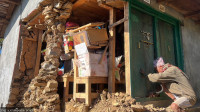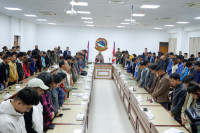Columns
Gearing up for Sagarmatha Sambaad
We must define our position and advocate for climate justice to broaden partnerships for mountain-specific advocacy.
Popular Gentle
The much-anticipated Sagarmatha Sambaad is set to kick off in Kathmandu in the second week of May. The event, themed “Climate Change, Mountains, and the Future of Humanity,” will discuss the issues of the Himalayas in the international arena.
Nepal’s advocacy on mountains and climate change at the global forum dates back over two and a half decades. The 2009 Kala Patthar cabinet meeting of the government and its manifestation at the Copenhagen COP15 were symbolic in drawing international attention to this agenda. Following this, the mountains, people and climate change have remained at the forefront of Nepal’s policies and agenda for global dialogue.
Nepal has been working to include the mountain and climate change agenda as a core business of the United Nations Framework Convention on Climate Change (UNFCCC). UN Secretary-General António Guterres, during his visit to Nepal in 2023, emphasised this and highlighted the importance of global solidarity and immediate action to address the impacts of climate change. Nepal’s voice on COP28 further continued this momentum. During the event, Prime Minister Pushpa Kamal Dahal led a high-level roundtable discussion titled “Call of the Mountain: Who Saves Us from the Climate Crisis?” Similarly, an “International Expert Dialogue on Mountains, People and Climate 2024” was also organised in Kathmandu.
Building on this journey, the upcoming Sagarmatha Sambaad was included in the government’s annual programme 2024-25 to advance solidarity for the mountain agenda.
The mountainous regions are rich in biological and cultural diversity, providing vital goods and services to people not just living in and around the area, but globally. However, the Intergovernmental Panel on Climate Change (IPCC)’s sixth assessment report warns of the consequences of climate change impacts on mountain ecosystems, culture and tourism, water and food security, and the effects of climate-induced disasters on people, nature and sustainable development. Almost 84 percent of endemic mountain species are found to be on the verge of extinction. Glacial lake outburst floods pose a perennial threat, with current emission pathways suggesting that 80 percent of the glacier’s volume could disappear by 2100.
Despite being one of the least contributors to greenhouse gas emissions, Nepal is facing the impacts of climate change and climate-induced disasters that threaten its potential growth areas, including hydropower, agriculture and infrastructure development. We are losing about 2 percent of our GDP due to climate change’s impacts that are differential and disproportionately affect women, the poor, socially disadvantaged and natural resource-dependent communities. There is also a severe lack of resources and technology to adapt to the changes and recover from losses and damage caused by devastating disaster events.
Reflection for discussion
Reflecting on our past journey is crucial for identifying key areas for discussion in the Sambaad. There is a need to advocate for climate justice, demanding finance, technology and capacity building as provisioned in the Paris agreement and similar treaties.
We need to find a unified voice and synergy among participating countries and negotiate a win-win route between mountainous and downstream countries at the Sagarmatha Sambaad. This would be crucial to changing the current “rule of the game” established by global power centres. The discussion can also be an excellent avenue to promote Nepal’s successes in emission reduction and adaptation efforts.
Nepal can offer the global community valuable insights into how local stewardship in natural resource management has contributed to maintaining over 45 percent forest cover. Nepal can also share about its progress in clean energy and support global emission reduction by increasing the adoption of electric vehicles.
Beyond the upcoming multi-stakeholder dialogue, Nepal needs to capitalise on the opportunities created by the federal governance. Realisation of the potential of local, provincial and federal governments in designing and implementing context-specific climate actions at different scales is an opportunity to enhance the effectiveness of climate actions.
Likewise, there is an urgency to take the climate agenda into the mainstream in the development process. Policy and institutional reform is also needed to mainstream climate actions into a country’s development process, to make global advocacy for climate justice more effective, and to increase climate finance. In addition to better collaboration between governments, it requires effective vertical and horizontal coordination mechanisms between other relevant stakeholders.
Nepal also needs significant improvements in its capacity for global climate negotiations. Establishing a permanent negotiation team of experts with multi-sectoral expertise, competence and skills on global negotiation determines the country’s success in international advocacy for climate justice. This demands a shift from the current understanding of climate negotiation as a function limited to the technical domain to a realisation of it as a “whole-of-nation” approach.
Finally, the preparation and implementation of a strategic roadmap for Nepal’s journey to climate justice will help systematise our efforts. We must define our position and advocate for climate justice, providing evidence to support our claim and shaping our actions to broaden the global constituency and partnership for mountain-specific advocacy. The “Summary of the Chair”—conclusions from the international expert dialogue on Mountains, People and Climate in Kathmandu, 2024—should be considered one of the key references for Sagarmatha Sambaad.




 18.12°C Kathmandu
18.12°C Kathmandu















